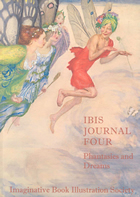
IBIS Journal 4: Phantasies and Dreams

Journal 4 has articles on three very different artists working in different periods, linked by their delight in illustrating fairy and fantasy tales and their originality of approach to such material. Chrono-logically, the first of the subjects is the illustrations by Arthur Hughes for the periodical Good Words for the Young. From 1869 to 1874, he illustrated a number of serial stories by George MacDonald and others. Most important perhaps are those for ‘At the Back of the North Wind’ in which his depiction of the North Wind herself has become inseparable from the story. Maroussia Oakley explores the relationships between artist, publisher and authors, tracking the ways in which the illustrations were subsequently reused and misused. She provides a full bibliography of the illustrations as they appeared in both periodicals and in books.
Robert Anning Bell was a versatile decorative artist who worked as an illustrator between 1889 and 1912. His earliest illustrations were for Nister, working in the publisher’s house style, but he was able to develop a personal style in a series of commissions for Sylvia’s Journal in 1893 and in the first two volumes of Dent’s ‘Banbury Cross’ series. The book that established his reputation as a leading illustrator of his day was A Midsummer Night’s Dream. John McIntyre sets Anning Bell’s career as an illustrator in the context of his life and suggests a wide range of influences that might have shaped his work. He shows how his illustrations were the inspiration for a number of paintings and other works in the field of the decorative arts. The article is accompanied by a full bibliography of Anning Bell’s published illustrations in both books and magazines.
Florence Mary Anderson produced most of her best illustrations during and immediately after the Great War, in a period of austerity. Her subject matter was almost exclusively concerned with magic and the fairy world, and to this she brought a fresh eye, appealing to her child audience without lapsing into sentimentality as many of her contemporaries were prone to do. Peter Cope has compiled a meticulous bibliography of her work, identifying its appearances in periodicals, annuals, and books, charting the way in which her illustrations were reused, sometimes many times over, and sometimes appearing in two publications simultaneously.
The journal has 144 pages, numerous illustrations, many in colour, handsomely bound in glossy covers.
Copies of Journal 4 may be purchased by members and non-members. Click on "How to Buy" in the menu on the left for more details.